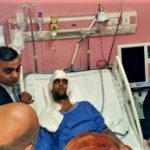By Karoline Kamel – MadaMasr –
Church reports contradict claims that those killed in Minya put themselves at risk, reiterate calls for increased security on the road into St. Samuel.
In the wake of a deadly attack that left seven Coptic Christians dead, church officials say repeated appeals for increased security measures along the road where the ambush happened went unheeded in the months leading up to the incident. Their account of the attack also contradicts police claims that the victims drove along an unguarded side road, a narrative that implies they put themselves at risk.
At least seven people were killed and nearly 20 injured on Friday in a militant attack on two buses and a microbus carrying Coptic Christians returning from the St. Samuel Coptic Orthodox Monastery in Upper Egypt’s Minya Governorate.
Pilgrims drive along an unpaved road to reach the remote desert monastery. Militants carried out a similar ambush in almost the exact same location in May 2017, killing 28 Copts and at least 20.
Hours after Friday’s attack, the State Information Service released a statement quoting a security official who claimed that the victims took side roads to reach the monastery because “the main road to the monastery was closed upon security instructions, given its dangerous location in the desert borders of the governorate, and due to a lack of telecommunication network coverage in the area.”
Church officials have directly contradicted that account. In a statement issued on Tuesday that cites survivors’ testimonies, the Maghagha and Adwa Archdiocese said the buses used the main entrance to the unpaved road leading to the monastery, “and not any other roads, as has been claimed.”
Meanwhile, a monk who guards the gates of the monastery tells Mada Masr that there are no side roads leading to the monastery and the unpaved road where the attack occurred is the only route in.
Friday’s attack occurred at the midway point of the road, approximately 10 km from the monastery and the main entrance to the road, according to sources inside the monastery.
The monk, Daoud al-Samouili, adds that the security checkpoint at the entrance to the road is only stationed there from 6 am to 6 pm and that the buses carrying the victims arrived at the entrance to the road before 6am. “Perhaps to avoid accusations of security negligence for not having the checkpoint, they said that the buses took a side road, which people know does not exist,” he suggests.
According to Samouili, after last year’s attack, visits to the monastery were halted before resuming again several months later but restricted to just one day a week, on Fridays. A second security checkpoint was also established in front of the monastery gates. Yet those measures appear to fall far short of church demands for improved security precautions following the May 2017 ambush.
According to the statement issued Tuesday, the Maghagha and Adwa Archdiocese made several demands for improved security measures last year, including a permanent security presence at the entrance to the monastery road, a police patrol to secure trips to and from the monastery, paving and lighting the road, installing surveillance cameras and reinforcing mobile coverage to facilitate communication in the area. None of those demands appear to have been met.
Senior Interior Ministry and local officials visited the monastery following Friday’s attack. According to Samouli, officials discussed with the monks the idea of suspending visits to the church.
The Islamic State claimed responsibility for the attack in a statement released on Friday evening by its media arm, the Amaq News Agency. In a second Friday statement attributed to the militant group, in which a higher death toll of 13 is cited, they purport that the motive for the attack was to avenge the imprisonment of “our chaste sisters.”
The Interior Ministry announced the killing of 19 people, whom it described as “among the elements of the cell that committed the Minya terrorist attack,” in a Sunday statement. The individuals were killed in a shootout at a hideout in the desert area to the west of Minya. The statement did not mention any casualties among the security personnel involved in the operation.
The attack came just one day before the opening of the second annual World Youth Forum in Egypt’s Sharm el-Sheikh resort. The event, touted by the state as an effort to promote youth innovation in the service of contemporary global concerns, concluded on Tuesday and was attended by President Abdel Fattah al-Sisi, who responded to the attacks on his official Twitter and Facebook accounts on Friday.
The president commented briefly on the attacks during a Sunday session of the youth forum, saying Egyptians should be free to worship as they please while downplaying that religious discrimination is pervasive in Egypt. “In Egypt, we no longer discriminate by religion. We don’t say, ‘they’re Muslim and they’re Christian.’ No. Now, we say, ‘they’re Egyptian’,” Sisi said. “When an Egyptian dies, whomever they are, it hurts us and it hurts all Egyptians.”
In recent years, the Islamic State has claimed responsibility for three operations targeting Copts, including last year’s attack in Minya. In April 2017, the group claimed responsibility for the twin Palm Sunday bombings that targeted the St. George Church in Tanta and St. Mark’s Church in Alexandria during celebrations for the Coptic Holy Week, resulting in dozens of deaths and injuries. In December 2016, the organization targeted the St. Paul and St. Peter Church in Cairo, adjacent to the Cathedral of St. Mark in Abbasseya, killing 25 and injuring dozens more.
_____________________
Translated by Hadeer El-Mahdawy





